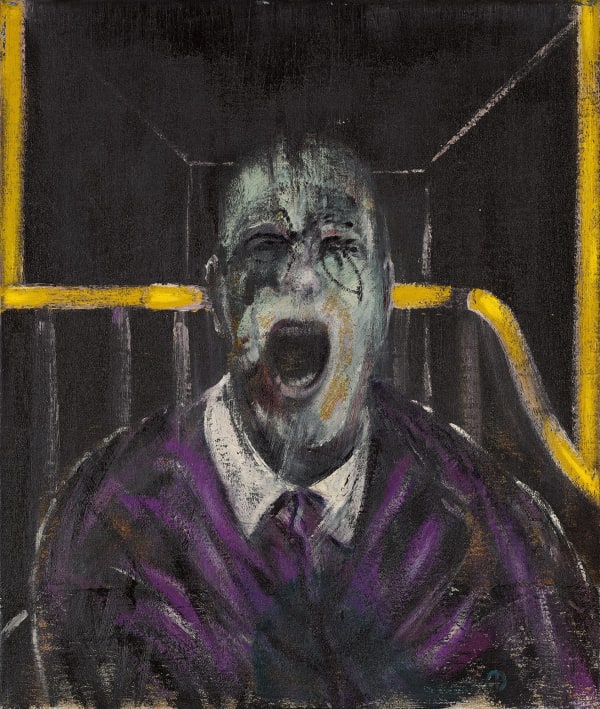-
Francis Bacon Prints For Sale.
Francis Bacon's art is a deep exploration of the human condition told through the revolutionary lens of a true genius. His distorted and contorted figures explore aspects religion, mythology & the deeply personal. Explore our latest Francis Bacon prints for sale at Guy Hepner, Bacon dealers since 2007.
Discover authentic Francis Bacon signed prints for sale below.
-
Works

Francis Bacon
Portrait of Michel Leiris from Miroir de la Tauromachie, 1990Lithograph18 7/8 x 14 1/8 in
48 x 36 cmEdition of 150Copyright The ArtistFrancis Bacon’s After Portrait de Michel Leiris is a powerful affirmation of his singular ability to transform portraiture into an arena of psychological and existential inquiry. Far from offering a...Francis Bacon’s After Portrait de Michel Leiris is a powerful affirmation of his singular ability to transform portraiture into an arena of psychological and existential inquiry. Far from offering a conventional likeness, Bacon reimagines his close friend—French writer, surrealist, and anthropologist Michel Leiris—as a fractured, emotionally charged presence suspended between abstraction and identity. This work, a lithographic interpretation of Bacon’s 1976 oil painting held in the Musée National d’Art Moderne in Paris, functions not just as a portrait, but as a metaphysical excavation of the human psyche.Leiris, a deeply introspective thinker who traversed both the literary and ethnographic worlds, provides an ideal subject for Bacon’s penetrating vision. Their close friendship imbues the piece with intimacy, yet Bacon refuses sentimentality. Instead, he dissects, distorts, and reassembles Leiris’ visage into a complex matrix of emotion, intellect, and existential anxiety. Bacon’s portrait becomes a space where personal acquaintance merges with universal themes—vulnerability, decay, and the elusive nature of identity.Central to the work is Bacon’s relentless deconstruction of the human form. As in much of his portraiture, he employs violent brushstrokes, contorted lines, and sweeping, gestural smears of color that dismantle the anatomical integrity of the face. Leiris’ features are rendered almost unrecognizable—obliterated by spiraling movements of paint and motion—yet one element remains sharply defined: the right eye. This single, piercing point of clarity amidst chaos acts as the painting’s anchor, a psychological eye that gazes not only outward at the viewer but inward into the fragmented soul of the sitter. It is through this eye that the portrait’s emotional gravity emerges, simultaneously drawing the viewer into its maelstrom and resisting full comprehension.Bacon’s technique here is less about representation than revelation. His distortions are not arbitrary but serve to externalize the inner fractures of the self. The swirling, almost violent application of pigment evokes a storm of feeling—a crisis of identity in motion. The composition is neither stable nor whole, mirroring Bacon’s conviction that the human condition is, by nature, unstable, chaotic, and in perpetual flux.In this way, After Portrait de Michel Leiris stands as a profound continuation of the modernist tradition that sought to expose, rather than conceal, the psychological truths of the individual. Bacon’s work finds a potent parallel in Edvard Munch’s The Scream (1893)—not in visual similarity, but in emotional resonance. Where Munch articulates existential anguish through the figure’s cry, Bacon enacts that anguish through the medium itself, using distortion as a form of psychological language. His portraits are not just expressions of suffering—they are embodiments of it.This connection is further deepened by Bacon’s resistance to conventional beauty or harmony. In his hands, Leiris becomes both a singular figure and an archetype: a symbol of the fragmented, vulnerable self that lies beneath every social facade. Bacon does not seek to flatter or immortalize his sitter. Instead, he strips away the masks imposed by culture, intellect, and self-presentation, revealing a raw, unsettling core. The portrait functions as a kind of emotional mirror—one that reflects not just Leiris, but the viewer’s own confrontation with mortality, identity, and disintegration.The “after” in the title serves as more than an indicator of chronology or medium—it becomes a statement of philosophical distance. This is not simply an image derived from the earlier oil painting; it is an evolved response, refracted through the lens of time, memory, and the artist’s deepening engagement with the metaphysical. By 1990, Bacon was in the twilight of his life, and works like After Portrait de Michel Leiris carry the weight of retrospection, legacy, and mortality.Ultimately, this work encapsulates the essence of Bacon’s mature vision: a portrait not as a mirror of physical appearance, but as an arena in which the deepest aspects of being—anguish, fragility, consciousness—are laid bare. Leiris, in Bacon’s hands, becomes both himself and a symbol of something far greater: the human struggle to maintain coherence in a world defined by entropy.After Portrait de Michel Leiris is a haunting, deeply moving expression of Bacon’s belief that truth in art lies not in perfection or clarity, but in distortion—in the honest depiction of our fractured, ephemeral selves. It is not merely a portrait; it is a philosophical statement, rendered in flesh and abstraction, about what it means to be human.For more information on Francis Bacon’s After Portrait de Michel Leiris or to buy Francis Bacon’s After Portrait de Michel Leiris contact our galleries using the form below.Overview"The job of the artist is always to deepen the mystery".
Francis Bacon is one of the most important artists of the 20th century and post-war movements. Arguably one of the finest and most celebrated artists of his generation, Bacon holds a pivotal role in contemporary art through his revolutionary approach to his craft. One of the great explorers of the human condition Francis Bacon and his art, touch on fateful mix of mythology, religion, love and death, and document our joys, sorrows and pains perhaps better than any other artist before or since.
The imagery of Bacon is one of pure expression rejecting the prevailing artistic style of abstraction of the era, in favor of a distinctive and disturbing realism and his distorted forms convey a sense of both beauty and despair. The dichotomy in Bacon’s prints and imagery can be seen through his raw use of violent, yet delicate colors as well as the marriage he makes between the figurative and abstract. It is this soft balance between the brutal and the subtle, the violent and the soft and happiness and anguish that make Francis Bacon’s art so important and collectible. A master of painting, and known for his large scale canvases, Bacon combines seemingly disparate tectures, colours and forms to ceate a whirlwind of emotion conveying and reaching the heart of his subjective matter. Equally so Franci Bacon's print output, often as apres, lithographs or signed prints, offer his most popular subjects including Pope Francis and his famous triptychs.
Whether new to collecting Francis Bacon prints or an experienced collector, Guy Hepner can help. Since 2007 we have assisted clients across the world to buy Francis Bacon prints in confidence. Whether iconic triptych, lithographs or apres, our experienced and knowledgeable team are on hand to help you achieve your collecting goals. From our New York and London galleries, offer a wide selection of authentic Francis Bacon prints for sale.
Contact info@guyhepner.com for our latest Francis Bacon prints for sale or to buy Francis Bacon original art. News
News-

London’s Frieze Week Record Breakers
A Guide to a Blockbuster Week of Sales October 20, 2025London’s marquee auction houses just concluded a blockbuster week of contemporary art sales, coinciding with the Frieze art fair. In a series of evening auctions...Read more -

A Collector’s Guide to Francis Bacon Prints
Why Collect Bacon March 14, 2025Francis Bacon remains one of the most powerful and influential artists of the 20th century. His raw, visceral works depicting the human form in distorted,...Read more




